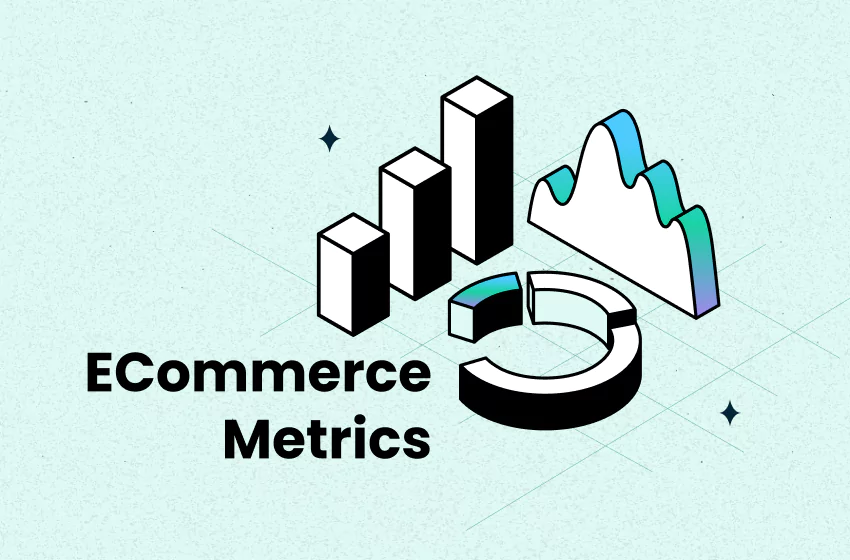15+ Essential eCommerce Metrics to Measure Success in 2025

Running a successful eCommerce business isn’t just about selling more—it’s about tracking the right numbers to optimize profitability and growth. But with so many metrics available, which ones truly matter? This guide breaks down the most important eCommerce metrics, why they matter, and how you can use them to make better business decisions.
eCommerce Metrics vs. KPIs: What’s the Difference?
While both involve numbers, the key difference is:
- Metrics track business performance but don’t always indicate success.
- KPIs are the most critical metrics that align directly with business goals.
For example, traffic is a metric, but conversion rate is a KPI because it directly impacts revenue.
Essential eCommerce Metrics to Track (with Benchmarks)
Here’s a breakdown of the top metrics you should monitor, why they matter, and how to improve them.
Metric | What it is | Benchmark |
|---|---|---|
Net Profit | The actual earnings after all costs | Varies by industry |
Net Profit Margin | Percentage of revenue that turns into profit | 10-20% (average) |
Gross Profit | Revenue minus the cost of goods sold (COGS) | 30-50% margin |
Operating Profit | Profit after operating expenses | 10-15% (average) |
ROAS (Return on Ad Spend) | Revenue generated per $1 spent on ads | 3-4x (good) |
AOV (Average Order Value) | The average amount spent per order | $50-$100 (varies) |
Conversion Rate | Percentage of visitors who buy | 2-3% (average) |
Customer Lifetime Value (CLV) | Total revenue expected from a customer | 3-5x CAC |
Customer Acquisition Cost (CAC) | Cost to acquire a new customer | Varies by niche |
Returning Customer Rate | Percentage of customers who buy again | 20-30% (healthy) |
Churn Rate | Percentage of customers who stop buying | Below 5% (ideal) |
Click-Through Rate (CTR) | Percentage of ad clicks per impression | 2-3% (Google Ads) |
Traffic | Total visitors to your store | Varies by source |
Bounce Rate | Percentage of visitors who leave without interaction | Below 50% (ideal) |
Time on Site | How long visitors stay on your store | 2-3 minutes (average) |
Here’s a breakdown of the top metrics you should monitor, why they matter, and how to improve them.
Net Profit
Net profit is the actual earnings after all expenses, including COGS, marketing, and operations. It’s the best indicator of overall business success.
- Why It Matters: It determines your real earnings and sustainability.
- Benchmark: Varies by industry.
- Formula:
- How to Improve Performance: Reduce unnecessary expenses, optimize pricing, and increase AOV.
Net Profit Margin
Net profit margin is the percentage of revenue that turns into profit after all expenses.
- Why It Matters: Shows how efficiently your business converts sales into profit.
- Benchmark: 10-20% (average).
- Formula:
- How to Improve Performance: Increase prices, cut costs, and optimize marketing spend.
Want to quickly calculate your profit margins? Try our Free Profit Margin Calculator to see your real earnings instantly.
Gross Profit Margin
Gross profit margin is the revenue minus the cost of goods sold (COGS).
- Why It Matters: Reflects the profitability of your products before operating costs.
- Benchmark: 30-50% margin.
- Formula:
- How to Improve Performance: Negotiate better supplier rates and reduce production costs.
Operating Profit
Operating profit is what remains after subtracting all operating expenses but before interest and taxes.
- Why It Matters: Shows how well the business manages costs.
- Benchmark: 10-15% (average).
- Formula:
- How to Improve Performance: Streamline operations and reduce overhead costs.
ROAS (Return on Ad Spend)
ROAS measures the revenue generated per dollar spent on advertising.
- Why It Matters: Helps evaluate ad campaign effectiveness.
- Benchmark: 3-4x (good).
- Formula:
- How to Improve Performance: Optimize ad targeting and experiment with creatives.
Average Order Value (AOV)
Average order value calculates the average amount spent per order.
- Why It Matters: Increasing AOV boosts revenue without acquiring new customers.
- Benchmark: $50-$100 (varies).
- Formula:
- How to Improve Performance: Optimize ad targeting and experiment with creatives.
Conversion Rate
Conversion rate is the percentage of visitors who complete a purchase.
- Why It Matters: Directly impacts revenue and marketing efficiency.
- Benchmark: 2-3% (average).
- Formula:
- How to Improve Performance: Optimize website UX, simplify checkout, and use trust signals.
Customer Lifetime Value (CLV)
Customer Lifetime Value estimates the total revenue expected from a customer over their relationship with your store.
- Why It Matters: Helps assess long-term profitability.
- Benchmark: 3-5x CAC. (LTV:CAC ratio should be 3:1)
- Formula:
- How to Improve Performance: Improve retention with loyalty programs and personalized offers.
Customer Acquisition Cost (CAC)
CAC is the cost to acquire a new customer, including ad spend and marketing costs.
- Why It Matters: Determines how efficiently you attract new customers.
- Benchmark: Varies by niche.
- Formula:
- How to Improve Performance: Use organic traffic strategies and referral marketing.
Returning Customer Rate
The percentage of customers who make repeat purchases.
- Why It Matters: A high rate indicates customer loyalty and reduced reliance on new acquisitions.
- Benchmark: 20-30% (healthy).
- Formula:
- How to Improve Performance: Offer loyalty programs, personalized discounts, and excellent customer service.
Churn Rate
Churn rate is the percentage of customers who stop buying from you over a period.
- Why It Matters: High churn means you’re losing customers faster than acquiring them.
- Benchmark: Below 5% (ideal).
- Formula:
- How to Improve Performance: Improve product quality, customer support, and engagement strategies.
Click-Through Rate (CTR)
Click through rate measures the percentage of ad clicks per impression.
- Why It Matters: Helps optimize paid ad performance.
- Benchmark: 2-3% (Google Ads).
- Formula:
- How to Improve Performance: Write compelling copy, use high-quality images, and A/B test ads.
Traffic
Traffic represents the total visitors to your store from all sources.
- Why It Matters: More visitors mean more potential buyers.
- Benchmark: Varies by source.
- Formula:
- How to Improve Performance: Improve SEO, run targeted ads, and leverage social media.
Bounce Rate
Bounce rate is the percentage of visitors who leave your site without interacting.
- Why It Matters: A high bounce rate signals poor user experience.
- Benchmark: Below 50% (ideal).
- Formula:
- How to Improve Performance: Optimize site speed, improve content relevance, and use engaging CTAs.
Time on Site
Time on site tracks how long visitors stay on your store before leaving.
- Why It Matters: Longer time suggests better engagement.
- Benchmark: 2-3 minutes (average).
- Formula:
How to Improve Performance: Improve site navigation, create engaging content, and add videos.
How Often Should You Check eCommerce Metrics?
To stay on top of your store’s performance, you need to monitor different metrics at different frequencies. Some require daily checks, while others can be reviewed less frequently.
- Daily: Traffic, conversion rate, ROAS, CTR
- Weekly: AOV, bounce rate, time on site, CAC
- Monthly: Net profit, gross profit, CLV, churn rate
- Quarterly: Net profit margin, operating profit, returning customer rate
How to Track eCommerce Metrics Effectively
To avoid data overload, use tools that consolidate your metrics:
- Google Analytics – Traffic, bounce rate, time on site
- Shopify Analytics – Sales, AOV, returning customers
- TrueProfit – Net profit, CAC, CLV, ROAS (for real-time profitability tracking)
Building your store, establishing your brand, developing your product, and providing excellent customer service are just a few of the many aspects of running a successful eCommerce business.
Tracking and analyzing the important eCommerce metrics listed above will help you evaluate how successful your business is doing those tasks and point out any areas in which you can fine-tune your strategies to increase the efficiency and profitability of your store.
Harry Chu is the Founder of TrueProfit, a net profit tracking solution designed to help Shopify merchants gain real-time insights into their actual profits. With 11+ years of experience in eCommerce and technology, his expertise in profit analytics, cost tracking, and data-driven decision-making has made him a trusted voice for thousands of Shopify merchants.




 Shopify profits
Shopify profits